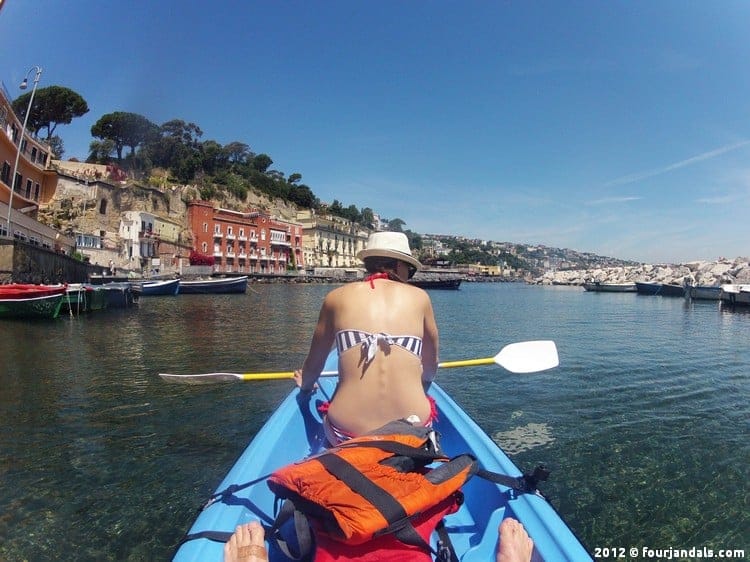2012 was an incredible year of travel adventures for us. We used our money saving tips for travel and visited 14 countries. We were quite honestly living the travel dream.

Kayaking in Naples, Italy
While some may think we are loaded with money, they would be very wrong.
In reality, the way we manage to have so many travel adventures around the world is because we prioritise and follow achievable money saving tips for travel.
With a little organisation about how we live on a day to day basis, we are able to save more money to travel.
Set your travel goals first
Before you read on, set two goals; where you want to travel and how long for. There is no point saying you want to travel around the world for 12 months if you only are willing to save $1000.
While I am sure there must be a way to travel for 12 months on $1000 (let me know if you find out how), it is important to be realistic about your travel budget. If you stay in 5 star resorts then you obviously need to save a little more money, than if you stay in backpacker accommodation.

Additionally, if you only want to go on a 2 week trip to the perfect vacation destination then you don’t have to save as much. If you want to enjoy an island paradise why not fly to Bali. You can enjoy island life, the amazing beaches and water sports all within your budget. Most people believe that beach front hotels are really expensive, but with little effort you can find great deals on ocean front Bali hotels. You can always use Marriott Rewards too.
If you don’t know which accommodation you would prefer, then check out our Hostels vs Hotels vs Apartments article.
6 Basic Money Saving Tips for Travel
With your travel goals set, you can use these 6 basic money saving tips to start travelling to help get you on the road to your own travel adventures in 2013.
Start Saving
Yup that’s right, start saving. You have to actually make a commitment to saving before you can even begin. There is no point going into this half-a$$ed if you are just going to give up in a few weeks.
Open a new bank account with a good interest rate and deposit your first $1. Ideally it would be more than that if you can afford it, but depositing the first $1 means that you have started!
Work out your necessary expenses budget
While it would be great if we could save every penny we make, there are some necessary expenses. You need to eat, put a roof over your head etc. Luckily you can quite easily figure out what your necessary expenses are.

Cut your expenses so you can eat gozleme in Turkey.
And once you have those, you will know how much of your pay cheque you can afford to save. Anything extra should go straight into your bank account removing any temptation for you to make impulse purchases.
Use Cash and get a Piggy Bank
With your necessary expenses worked out you should know exactly how much cash you will need each week. By only getting out a set amount of cash each week you will limit how much you spend with the rest of your pay cheque going into savings.
Any coins from your wallet can also be thrown straight into your piggy bank (or jar). It is amazing how quickly loose change adds up. Within a few weeks you will have enough for another nights accommodation or a nice meal out.
The other benefit is that if you remove the coins then you are less likely to use those coins to buy small treats all the time too.
Change your spending habits
You will need to make sacrifices when you begin to save money for your own travel adventures in 2013. It is important to remember in the back of your mind that you are doing it for a reason…

Is this reason enough to save money for travel?
Take a look at what you spend your money on at the moment. Every time you buy a cup of coffee, round of beers, go out for lunch or drive to work, they all cost you savings. Money that you could have used while travelling.
By cutting out these small purchases, you will rapidly increase your savings in your new bank account.
Sell your unwanted stuff
Now that you have cut down on a bunch of expenses, you should have some extra money building up every time youe pay cheque comes in.
One trick to boosting your savings right before you leave, is to look at selling some of the things lying around the house. Depending on how long you are travelling for depends on what you can sell. If you are going for a year or more then look at your electronics first.
Realistically, in a years time some of the electronics you own might be getting out of date. While they might be worth money now, they probably won’t be in another years time.
Look at your old clothes, books and furniture. Anything you don’t need in your backpack for your travel adventure can probably be sold.

Finally, treat yourself
Okay so this isn’t a money saving tip. But saving is damn hard work. You have to make sacrifices from your usual daily lifestyle to be able to save money for travel. That is why it is important to treat yourself every once in a while to stay sane.
Just don’t go crazy!
Limit yourself to grabbing a beer with your mates, go out for dinner with your loved one or just rent a movie to chill out. By treating yourself, only very rarely, you will be able to save for a lot longer.
This will allow you to get out and begin to enjoy your travels. The best place to start is to get all your vacation rentals tips and ideas from here, before getting out and spending that hard earned cash.
So where are you going to go with all your money saved?